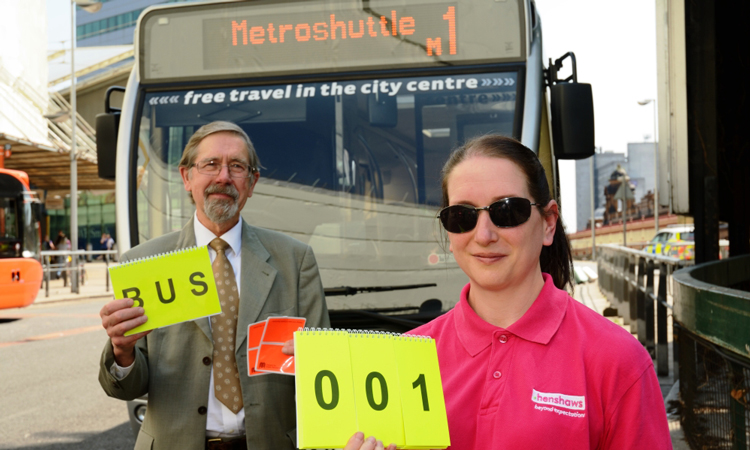Making public transport safe and accessible for people living with vision impairments
- Like
- Digg
- Del
- Tumblr
- VKontakte
- Buffer
- Love This
- Odnoklassniki
- Meneame
- Blogger
- Amazon
- Yahoo Mail
- Gmail
- AOL
- Newsvine
- HackerNews
- Evernote
- MySpace
- Mail.ru
- Viadeo
- Line
- Comments
- Yummly
- SMS
- Viber
- Telegram
- Subscribe
- Skype
- Facebook Messenger
- Kakao
- LiveJournal
- Yammer
- Edgar
- Fintel
- Mix
- Instapaper
- Copy Link
Posted: 7 November 2016 | Muhammad Karim - TfGM | No comments yet
In this article Muhammad Karim, Diversity Coordinator at Transport for Greater Manchester (TfGM), discusses the different ways TfGM is helping to make travel easier and safer for blind and partially sighted passengers.


From left to right: Chris Bowles (Chair of One Bus), Muhammed Karim (TfGM), Gail Brett (Henshaws), Glynis Howard (Henshaws), and Councillor Fender (Chair of the TfGM Committee).
For blind and partially sighted people, travelling by public transport can sometimes be a challenging experience.
It’s important to make transport networks accessible and easy to use for people living with a visual impairment, as they are often wholly dependent on public transport to make a journey. Helping visually impaired people feel confident and safe when travelling alone is important in order to empower this community and ensure they are able to access key facilities – in particular, employment, healthcare and learning.
TfGM is continually looking at ways of making public transport accessible to as many people as possible. One way that we have learned to understand the challenges experienced by visually impaired people is by working in partnership with charities that support people with sight loss. Henshaws is one such charity that we have been working with for a number of years.
Henshaws run regular sessions on ‘living with sight loss’ to help people adapt to life with a visual impairment. TfGM supports these sessions by giving information about how the public transport system in Greater Manchester has been designed and adapted to help blind and partially sighted people retain their independence.
Part of Henshaws’ session also features a discussion, which helps us to gain valuable insights into living with visual impairments.
Earlier in 2016, to help make travel easier for people living with sight loss, TfGM launched two new products designed in partnership with Henshaws; an orange bus pass wallet and bus hailer.
The orange pass wallet indicates to bus drivers that visually impaired passengers may require additional assistance to make a journey. It is fluorescent orange to alert bus drivers from a distance that a visually impaired person is waiting at a bus stop. Bus drivers in Greater Manchester are trained in offering advice and assistance to visually impaired passengers when they are boarding a bus and during a journey.
The yellow bus hailer is a flip pad that consists of bold and embossed numbers and letters, with the braille version underneath to enable braille users to select the number of the bus service they require. Users select the number of their bus and display it to oncoming traffic, signalling to the bus driver that they need to stop. The word ‘bus’ can be displayed if users are unsure of their bus number, or if more than one bus would take them to their destination.
TfGM worked closely with Henshaws during the design of the products, listening to feedback from visually impaired people and drawing on similar initiatives by local authorities and transport industry peers.
Robert Cooper from Henshaws said: “Everyone has the right to an independent life and being able to travel, for work or leisure, is key to this. Thanks to initiatives like this, people with sight loss can look forward to a more positive future.”
Debbie Abrahams MP added: “It is fantastic that TfGM recognises the needs of disabled people. The bus hailer and orange pass wallets are simple and cost effective products that have the potential to greatly improve the quality of life for vision impaired people.”
The free bus hailers and orange pass wallets are available in Travelshops at bus stations across Greater Manchester and from Henshaws. Both products are designed to withstand all weather conditions and the bus hailers have instructions for use in braille and text.
Following the launch of the scheme TfGM was shortlisted for Visual Impairment Friendly Business of the Year at the Henshaws Awards 2016. The products have received positive feedback from users.
In addition, we improved the way that passenger information is provided on a selected number of buses to assist people with sight and hearing loss.
Earlier this year TfGM retrofitted new passenger information screens to 20 Metroshuttle buses that operate a free service within Manchester city centre. The 19-inch high-resolution screens provide automatic next stop audio and visual announcements for passengers when making a journey, as well as places of interest and nearby businesses.
TfGM’s commitment to making the transport network more accessible is also evident on the Metrolink network. Each Metrolink stop has help points on the platform where passengers can request assistance should they have any problems when making a journey. An intercom communication system for passengers to contact the driver if assistance is required is also available on-board the trams.


Councillor Andrew Fender, Chair of TfGM with Gail Brett from Henshaws. Used at bus stops, the yellow bus hailer is a flip pad that consists of bold and embossed numbers and letters, with the braille version underneath to enable braille users to select the number of the bus service they require.
Metrolink’s on-board features have been designed to improve access for all passengers. For example, trams feature contrasting floor colours so that passengers can find exits more easily, and doors contrast in colour with the side of the tram to make it easier for visually impaired people to board and alight. The doors sound audible warnings so that passengers know when doors are being opened or closed, and on which side they are open. The timing of the doors opening coincides with the on board ‘next stop’ audio announcements to assist visually impaired passengers waiting on the platform.
Guide dogs (and assistance dogs) are welcomed on Metrolink when accompanying a disabled person. Other dogs cannot be brought on to Metrolink to avoid unsettling assistance dogs. Making sure all our customers can travel safely and that the network is operated responsibly is our primary concern.
Through the Greater Manchester Strategy we already have a vision for 2020: ‘a new model for sustainable economic growth based around a more connected, talented and greener city region where all our residents are able to contribute to and benefit from increased prosperity’.
Within this strategy it is important that the transport network is made as accessible as possible. A city that is more accessible and better connected helps to build greater economic prosperity and transforms skills.
The Disability Design Reference Group (DDRG), in particular, plays a crucial role in ensuring that accessibility for passengers will be fully embedded in the Greater Manchester transport network of the future.
The DDRG was established in 2008 at the start of Metrolink’s expansion and is comprised of disabled individuals from across Greater Manchester.
The aim of the DDRG is to improve the experience for disabled people using public transport by optimising the accessible design of vehicles and facilities. They assist TfGM and our partners in ensuring that, as far as possible, an inclusive barrier-free environment is developed across our projects and initiatives. The DDRG has been recognised as a model of best practise by the Equality and Human Rights Commission and has won a number of high profile national awards.
DDRG members’ first-hand experiences and solution driven advice is a vital part of the delivery of a number of TfGM projects. For example, we are currently constructing a new transport interchange in Bolton and the DDRG has provided practical advice on accessibility during the design stage.
Once completed Bolton Interchange will feature contrasting floor finishes to mark waiting areas and other spaces – partially sighted people benefit from contrasting features of this kind. The layout of each bus stand within the interchange is consistent, providing a common design that passengers will become familiar with. The overall arrangement of the interchange ensures there are clear paths throughout – for example, balustrades or concrete upstands are placed in clear lines to aid navigation. In addition, step-free access throughout the interchange will benefit many customers, including wheelchair users or people with prams and buggies.
Ongoing engagement with the DDRG takes place on a monthly basis – presentations are given affording the opportunity to discuss, debate and provide solutions to accessibility issues. Construction site visits are also regularly undertaken to review facilities and provide an opportunity for feedback. We’re continuing to work closely with charities too; listening to feedback and finding ways of offering visually impaired passengers new aids and schemes to make their journeys that bit easier.
Products and design innovations across the transport network have the potential to greatly improve the quality of life for blind or partially sighted people, as well as people with other impairments, helping them to feel more confident and safe when making a journey.
Biography


Related topics
Passenger Accessibility, Passenger Experience
Issue
Issue 6 2016
Related cities
Greater Manchester, United Kingdom
Related organisations
Transport for Greater Manchester (TfGM)
Related people
Muhammad Karim







